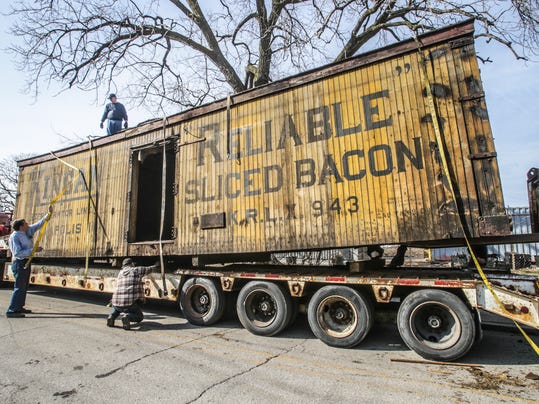Not too long ago there was a thread about surviving wood-side billboard reefers, which disappeared in the 1930s after Federal regulations banned advertising on railroad cars. At least as discussed on that thread, there were no originals left that anyone could name (the Coors car at the Colorado State Railroad Museum is a wood-side reefer, but is a repaint to represent the original Coors reefers). Well, there's at least one. Here's an article from 2014 about an original one (a 36' woodside reefer) that was discovered in Indianapolis, and which will be preserved. Pretty interesting story. There's also a nice video at the site with a narrator discussing the car, and more photos.
'Reliable Sliced Bacon' train car on track for restoration
Some 75 years ago, a refrigerator line train car that played a key role in a thriving Indianapolis meatpacking industry was taken out of service.
The car was protected for decades, used for storage inside a building that had been constructed around it. Now the 104-year-old relic is on its way to being restored for the public to enjoy.
The nonprofit Indiana Transportation Museum rescued the former Kingan Co.'s "Reliable Sliced Bacon" car from its former Downtown home on Friday. It moved the 12-ton car — lightweight compared with today's cars — to Kirklin, about 35 miles northwest in Clinton County, for safekeeping.

1910 train car saved from building demolition goes to Indiana Transportation Museum
"We're very, very lucky to be able to save the car," said Craig Presler, a museum volunteer. "We'll eventually be putting it back together.
"Ultimately, we'd like to get the train car operational," he added, though he couldn't predict when that would occur. "Trains are more fun when they run."
The car has historical significance to the city and Indiana.
Kingan Co., the first company to sell sliced bacon, was the biggest meat-packing company in the city and was a big employer here, Presler said. In the early 1900s, he said, meatpacking of beef and pork was the biggest industry in the state. One of Kingan's customers invented the method of preserving meat with ice, allowing meat to be shipped all over the nation in ice-filled cars year-round, Presler said.
The Noblesville-based museum, which restores train cars, obtained the car through a donation by Brian Fahle, CEO and president of Indianapolis apparel merchandising company Main Event Merchandise Group.
Fahle bought the property at 925 E. Vermont St. sight unseen a few years ago as an investment and didn't realize the train car was in the warehouse.
Recently, while he and his wife, Karen, were in the process of selling the property to a dog day care business, he said his real estate agent told him that the museum wanted to restore it.
"I thought the train was really cool, and I was looking for somebody to make better use of it than I could," said Fahle, an Indianapolis native.
The train car had been stored there by Kosnick Supply Co., a lumber supply firm. The company used the car to store all of its paper records for running the business, Presler said.
"They called it the closet. They uncovered it when closing down the business," he said. "We got a good look at it about 10 years ago, and we've been ... waiting for it to become available."
On Friday, a demolition contractor carefully took down the building around the car until 18 museum volunteers and a heavy-equipment mover were able to put the car onto a semitrailer using a forklift.
By today's standards, the car is small: 36 feet long, 9 feet wide and 9 feet tall. There are two hatches on the top of the car where ice was dropped.
The car will need repainting and new brakes, couplings and an undercarriage. But museum volunteers were surprised to find the car, built in 1910, in such good shape.
"Because it was indoors all these years, it's just in amazing condition," Presler said.
The museum operates more than 100 restored train cars for the State Fair FairTrain, Polar Bear Express and other public events and charter trips.
The car still has the original painting, including the wording "Kingan refrigerator line" and "reliable sliced bacon."
Cars like this one, known as billboard cars, were painted elaborately for advertising until the federal government said they couldn't be used for that purpose, Presler said.
"It's going to take time and money to make everything fit," he said. "But it will get repainted, I'm sure. It will look exactly like it did when it was in service."






